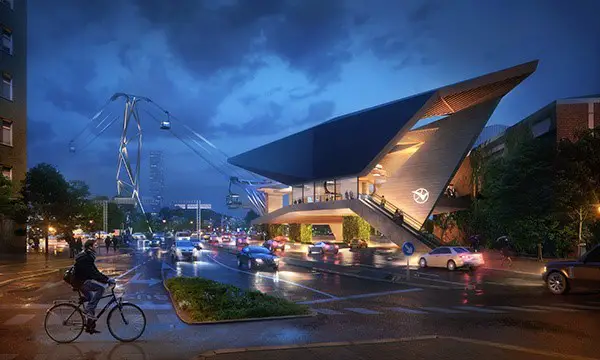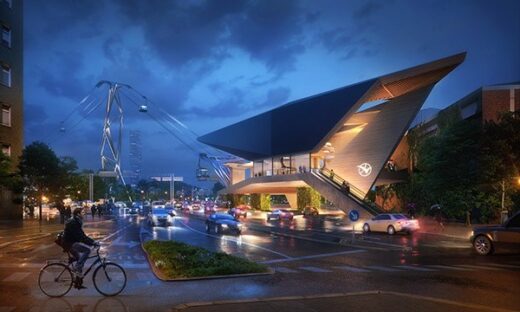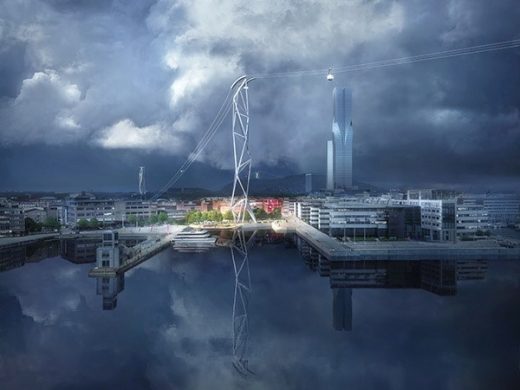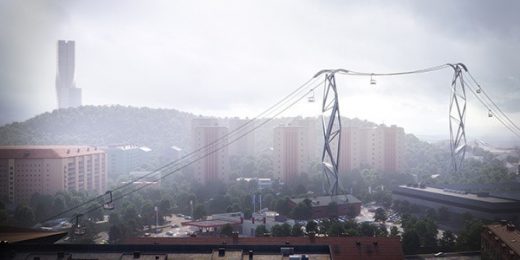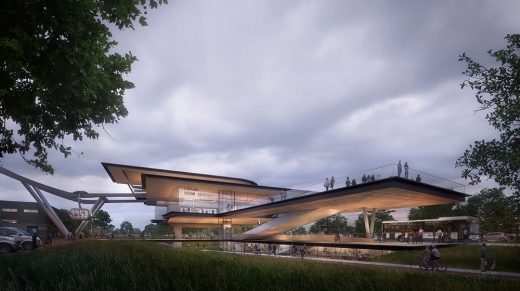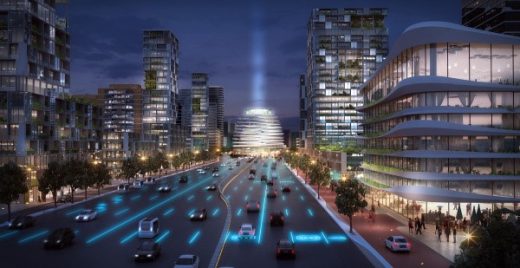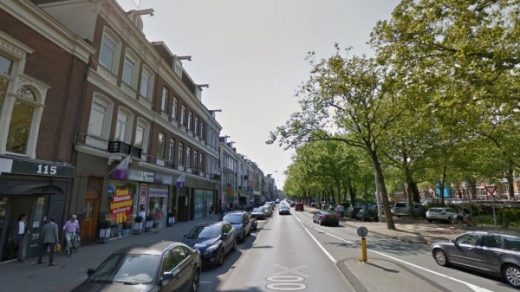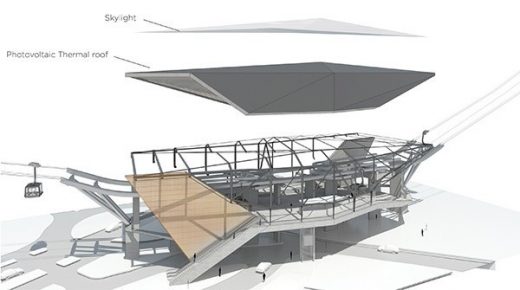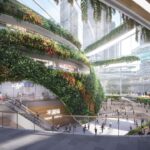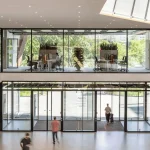UNStudio Sustainable Mobility Report, Cable Cars, Gondolas, Public Transport Architecture
UNStudio Sustainable Mobility Report
Green Public Transport design by UNStudio, Architects, Netherlands
7 Aug 2019
UNStudio Sustainable Mobility Report News
Smart and green mobility to futureproof cities
The world’s cities are facing an urgent set of challenges when it comes to ensuring a fundamental necessity of urban living: getting around. By 2030, 60 percent of the world’s population will live in cities, an increase of about 50 percent compared to today.
Gothenburg Cable Car design by UNStudio:

Today’s 1.2 billion strong global car fleet could double by 2030, while the amount of travel kilometers made within urban environments are expected to double, or even triple, by 2050. Most of our cities are not prepared for these developments.
UNStudio is currently involved in numerous mobility projects. Since the foundation of the practice, mobility has consistently been part of UNStudio’s DNA. From the Erasmus Bridge, to our first masterplan for Arnhem Central Station to the Mercedes Benz Museum – a true homage to mobility – most of our milestone projects demonstrate our special interest in this topic.
The following Mobility Report outlines the most recent projects UNStudio have been working on, ranging from strategic documents for municipalities, speculative designs (Hardt Hyperloop, A10), as well as architectural designs for the recently opened metro stations in Doha and of course the Cable Car in Gothenburg.
Designs for Gothenburg (images: Plompmozes)
The future of public transport: Cable Cars
Since winning the competition for a cable car system in Gothenburg, UNStudio have continued to develop our expertise in this very promising new form of public transport. Founder and Principal Architect of UNStudio Ben van Berkel says: “Cable car systems provide a new form of public transport that is sustainable, extremely fast, reliable and efficient. Although primarily a pragmatic solution, cable cars are also a very congenial way to travel as they enable city residents to see and experience their cities in a whole new way.”
Click here to listen to a podcast we have produced about the future of mobility and cable cars.
IJbaan and first ever cross border cable car
In addition to Gothenburg, UNStudio are participating in the IJbaan project in Amsterdam. Commissioned by the IJbaan Foundation (Stichting IJbaan), the cable car that connects the North of the city with the newly developed neighbourhoods in the West, is a grassroots “Amsterdammer” citizens’ initiative. It snowballed from a crowdfunding campaign led by Bas Dekker and Willem Wessels that started in 2015 and is now supported by the Municipality of Amsterdam.
To date, UNStudio made the concenpt designs for the cable car towers and the two transit hubs on both river banks. UNStudio look forward to moving on to the next phase and to developing the design further with the IJbaan foundation, in cooperation with the municipality and investors.
IJbaan in Amsterdam
IJbaan Cable Car in Amsterdam, Amsterdam, the Netherlands
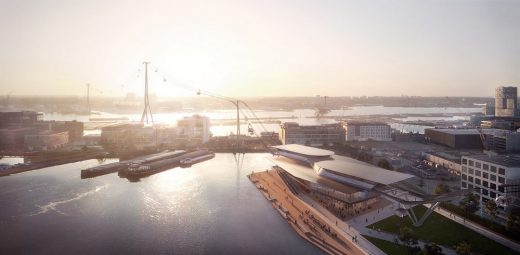
visual : Plompmozes
IJbaan Cable Car by UNStudio
Equally exciting is the winning design for a terminal station that UNStudio recently presented to our client for the first ever cross border cable car in Blagoveshchensk. The new system will span the river Amur, connecting Russia to China and vice versa. The design entails the cable car terminal on the Russian side of the river, that will become a cultural and leisure destination, connecting the nearby cultural square with the Golden Mile that runs alongside the river.
IJbaan Cable Car Amsterdam:
Cable car at the Russian Chinese border:
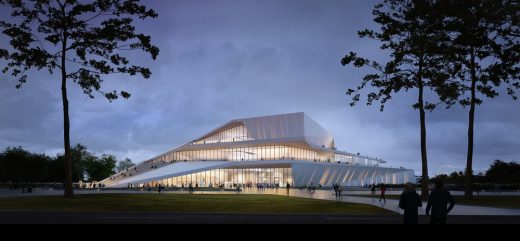
visualisation : PYXID
Blagoveshchensk Cable Car Terminal Russia design by UNStudio
Sustainable, green and efficient solutions
Whether it be public transport through the air, under ground, or even in capsules that travel at over 600 kilometers per hour – all of the mobility projects UNStudio are currently participating in share the same values. By offering a more sustainable, green and efficient alternative for moving through dense urban areas, the cable cars, the Hardt Hyperloop (see below) and the new metro network in Doha, all demonstrate the same urban design philosophy: they all aim to alleviate pressure on the city’s streets by getting people out of their cars and on to public transport.
These forms of transport enhance connectivity and serve urban development, whilst simultaneously helping to create healthier environments by reducing both urban congestion and C02 emissions. All of these solutions also enable cities to allocate more space to green areas, pedestrians, cyclists and other forms of personalised electric mobility in the future. By doing so, even increasingly dense cities can remain accessible and attractive.
Source: https://www.instagram.com/p/BqsXJg0HXjA/
Qatar Railways’ Doha Metro Network by UNStudio:
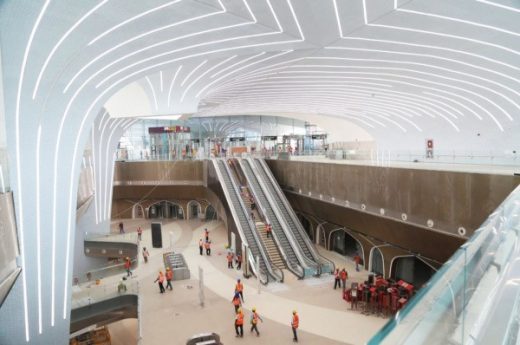
image courtesy of architects
Qatar Railways’ Doha Metro Network
Another mobility project that UNStudio have been working on over the last seven years – and that has just opened its first line to the public – is the Qatar Integrated Railway Project in Doha. For this project, UNStudio created the reference designs for the stations and, in collaboration with Qatar Railways, developed an Architectural Branding Manual that specifies design guidelines, architectural details and material outlines. Click here to take a trip around Doha on its first ever metro line.
Hardt Hyperloop: a sustainable and convenient alternative to flying
The Hardt Hyperloop Hub is a vision designed by UNSFutures for the European Hyperloop stations of the future, and a study of urban integration for the Hyperloop across cities and towns of different sizes.
Hardt Hyperloop Amsterdam design by UNStudio
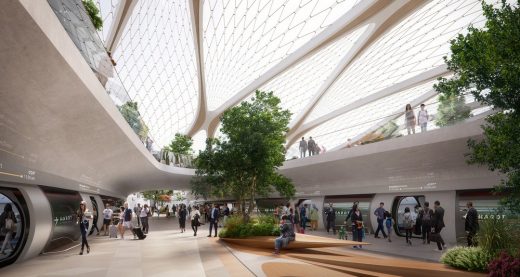
image © Plompmozes
Ben van Berkel, Founder and Principal Architect of UNStudio: ‘The Hyperloop is not only a realistic and viable alternative to flying, it is going to revolutionise travel. It will provide extremely fast travel times with direct connections between cities, enabling completely new ways of working and spending our leisure time, which in turn will lead to a multitude of economic, environmental and knowledge exchange benefits.’
Click here to listen to a podcast we have produced about the Hyperloop and the future of mobility.
Mobility vision for Amsterdam
UNStudio not only design solutions, but also collaborate with city governments and local municipalities to anticipate and strategise for possible future scenarios. In this respect, it is interesting to mention that the UNStudio’s Futures Team – a multidisciplinary team of researchers, futurists, architects, speculative designers and storytellers – in collaboration with Royal Haskoning and other partners, has recently finalised a mobility strategy for the municipality of Amsterdam that focuses on future urban mobility scenarios.
Climate goals are at the top of the agenda for the City of Amsterdam, which recently declared that by 2030 all city traffic should be electric, meaning that by that date all gasoline and diesel cars will be kept out of the city. With this ambitious goal, Amsterdam has put itself at the forefront, setting an example for cities worldwide.
As an architectural practice, UNStudio are proud to contribute to this ambitious future. The result of this process is a strategic design study entitled “Perspective on Mobility of the Future in Amsterdam” (Perspectief op Mobiliteit van de Toekomst in Amsterdam), that was recently presented by Sharon Dijksma, the local City Councilor for Traffic, Transport, Water and Air Quality.
The Green Mile on our doorstep
As an architectural studio UNStudio are of course highly concerned with the environmental impact and footprint of our designs. To reduce our own footprint as an office and to develop a greater understanding of how UNStudio can make our architectural and urban designs more sustainable and circular, a group of UNStudio employees took the initiative to form our very own Green Team. One of their first projects happens to be right on the doorstep of our Amsterdam office: the Stadhouderskade.
The Stadhouderskade has the unfortunate reputation of being one of the busiest and most polluted streets in Amsterdam, and even in the Netherlands. In an effort to change this, the Green Team has come up with the ambition to transform this main artery into ‘The Green Mile’.
The goal of the Green Mile is to reduce air pollution, noise and C02-emissions, and to create a greener, healthier public realm along the Stadhouderskade. Over the coming months UNStudio will invite different stakeholders who also use the street: the local community, residents of de Pijp and other businesses, to participate in the making of an urban plan that encourages a more sustainable approach to mobility and logistics on this busy stretch of road.
Arnhem Central: “A Celebration of Travel”
What happens with a building once it is completed and our work is done? How do users experience our designs on a daily basis? As it is one of the milestone projects in our portfolio, UNStudio were eager to find out what daily life looks like at Arnhem Central Station. For its 10th anniversary last year, the firm made a short documentary about the life of this station masterplan so far: “A Celebration of Travel”.
UNStudio Sustainable Mobility Report: Transport images / information from UNStudio Architects, The Netherlands
UN Studio Architects
Architecture in Sweden
Contemporary Architecture in Sweden
Swedish Architecture Designs – chronological list
UNStudio Netherlands practice information
Comments / photos for the UNStudio Sustainable Mobility Report: Transport page welcome

